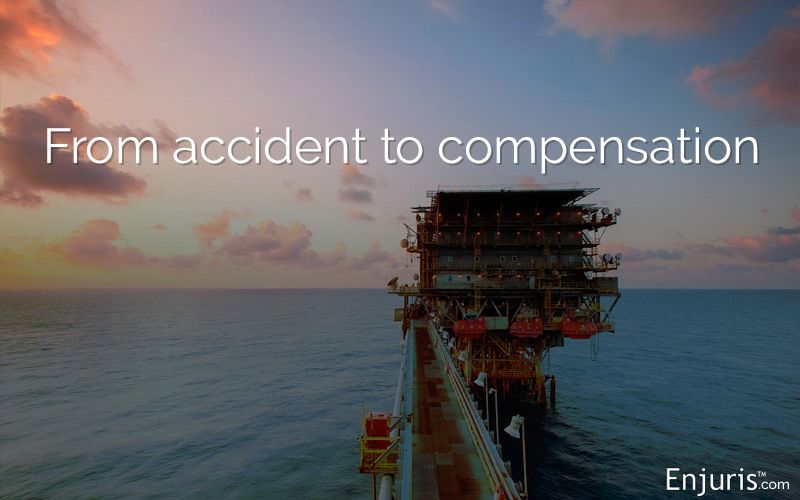
Understanding the risks and how to receive compensation after an offshore drilling injury
To say the oil industry is accident-prone is an understatement the size of the Deepwater Horizon oil spill.
Oil rigs are inherently dangerous and potential hazards combined with questionable safety standards have led to decades of serious injuries and deaths.
Texas is one of the leading states when it comes to oil and gas drilling. The industry provides Texans with thousands of job opportunities. Unfortunately, more job opportunities mean more employees are at risk.
Let's take a hard look at oil rig accidents in Texas.
Oil industry accident statistics
The Occupational Safety and Health Administration (OSHA) reports that more than 4,000 oil field workers are injured each year, and more than 100 workers are killed annually on the job.
The United States Bureau of Labor Statistics (BLS) reports that 663 workers were killed in oil field jobs between 2007 and 2012. The Houston Chronicle analyzed this data and found that Texas alone accounted for approximately 40% of these fatalities.
The Chronicle also found that 675 Texans suffered fractures, 92 workers suffered burns, 82 workers were crushed, and 79 workers suffered from amputations in 2012 alone.
Causes of oil rig accidents in Texas
Understanding why accidents happen can help prevent future disasters. What's more, understanding why a particular accident happened is critical to determining who might be at fault for the accident.
Let's take a quick look at some of the most common causes of oil rig accidents in Texas.
Explosions and fires
Explosions are a common occurence on oil rigs where workers are required to work with heavy machines and highly-combustible substances in rough, unpredictable weather.
Though the specific hazards that lead to an explosion or fire are endless, some common examples of potential hazards include:
- Improperly grounded electrical equipment or wiring
- Defective batteries
- Defective ventilation systems (which cause a back-up of hazardous fumes)
- Improperly stored fuel or other combustible substances
- Poorly maintained hoses, pipes, or pipelines that leak or spray fuel
- Improper use of welding devices or torches near combustible substances
- Corrosion of electrical equipment
- Failure to follow proper procedures for maintaining or cleaning equipment
- Human error
What makes oil rig explosions and fires even more terrifying is that local fire departments don't often know how to deal with such fires.
According to the National Fire Protection Agency, local fire response agencies, many of which are staffed by volunteers trained primarily in fighting structure fires, aren't familiar with oil industry activities and practices, and often don't have enough water, equipment, firefighters, training, and expertise to deal with fires involving large amounts of flammable material concentrated in a single area.
Defective products
Defective products may cause oil rig accidents. Simply put, workers may work with heavy machinery or equipment that isn't functioning properly and, as a result, is dangerous.
Inadequate training
As the oil and gas industry continues to expand, more inexperienced workers are hired.
As Ryan Hill, who heads the oil and gas extraction program at the Centers for Disease Control and Prevention's National Institute for Occupational Safety and Health explained:
“During times of high demand, there are new workers brought into this industry, and those are workers that may not have relevant training and experience. They didn't grow up around the industry, especially in some of the newer oil fields.”
Unfortunately, inexperienced workers can pose a risk to other workers on a rig.
In 2006-2007, the industry surged and fatalities skyrocketed. However, during the great recession of 2009, the oil industry was forced to layoff less-experienced workers and the death rate plunged nearly in half.
Improper oversight
A recent report indicates that OSHA has largely failed to implement proper safety standards and procedures, and hasn't conducted an adequate number of inspections. What's more, even when these inspections are taking place, oil and gas companies are routinely receiving safety violations.
The lack of adequate oversight is perhaps not surprising, as OSHA only has 95 inspectors to oversee safety rules and to investigate accidents throughout all Texas job sites. Additionally, drilling and well service industry lobbyists have continuously opposed reforms to oil operations.
Common oil rig injuries
Workers in the oil industry are typically required to wear hard hats and steel-toed boots, but even after taking these and other safety measures, injuries are bound to happen. Common oil rig accident injuries include:
- Bone fractures or breaks from being struck by objects
- Chemical or third-degree burns from well blowouts, fires, and explosions
- Head or brain injuries from falling pipes, cables, casings, and other equipment
- Paralysis due to falls from derricks, ladders, platforms, slick stairways, and other unguarded heights
- Limb loss as a result of being crushed by heavy cargo or machinery
One of the most important things you can do to ensure you receive the compensation you deserve for an oil rig injury is to keep track of all your medical records and your day-to-day pains.
 Post-Accident Journal Form
Post-Accident Journal Form
Sample accident journal/diary to help you document the effect on your daily life
Download in PDF format![]()
 Damages/Expenses Worksheet
Damages/Expenses Worksheet
Damages worksheet to track expenses for your injury claim (medical treatment, property damage, lost wages, prescriptions)
Download in PDF format![]()
Preventing oil rig accidents
Fortunately, there are several ways that oil rig accidents and injuries can be prevented. Employers should make sure the following safety measures are in place:
- Safety equipment, including eye masks, helmets, boots, and gloves
- Self-contained respiratory tools to guard against chemical exposure
- Anti-pressure devices to prevent explosions
Employers should also:
- Ensure that all tools and other items are safely stowed away to prevent unnecessary falls
- Inspect and maintain machines regularly
- Provide proper training for all workers
- Report any accidents immediately to the appropriate state and federal agencies
Legal options for injured workers
If you've been injured in an oil rig accident, you may be able to receive compensation for your injuries.
In most cases, it will be appropriate to either file a personal injury claim (in which case you will need to prove that someone else's negligence caused your injuries) or a workers' compensation claim (in which case you will need to prove that your employer carries workers' compensation insurance and that your injury took place while you were completing a work task).
With that being said, the nature of the oil and gas industry is such that there are a number of state and federal laws that might apply to your case. For this reason, it's important to speak to an experienced attorney before making any legal decisions.
Here's a quick look at some of the state and federal laws that might apply to your case:
- The Texas Water Safety Act addresses the duties of boat operators.
- The Texas Workers' Compensation Act provides benefits to employees of covered entities injured while at work regardless of fault. The Texas Workers' Compensation Act also provides compensation to certain family members of individuals killed while working.
- Texas wrongful death laws provide compensation to certain surviving family members.
- The Jones Act is a federal act that regulates maritime activities and provides medical compensation to the surviving spouse and/or children of a qualified deceased offshore worker.
- The Longshore & Harbor Workers' Compensation Act is a federal law that provides for the payment of compensation, medical care, and vocational rehabilitation services to employees disabled from on-the-job injuries that occur on the navigable waters of the US.
- The Death on the High Seas Act applies to workers who died more than 3 nautical miles outside of territorial waters and offers family members financial relief.
- The Oil and Pollution Act governs the process of compensation for injuries sustained by a spill or other refinery or rig catastrophes.
Know your rights
The law requires employers to provide employees with safe workplaces. OSHA also prohibits employers from retaliating against employees for exercising their rights under the law. For more information see www.whistleblowers.gov.
If you have questions or concerns about your worksite, find your regional OSHA office through the OSHA Offices by State webpage or call 1-800-321-OSHA (6742).
Workers can file a complaint with OSHA by calling 1-800-321-OSHA (6742), online via eComplaint Form, or by printing the complaint form and mailing or faxing it to the local OSHA area office.
You may also be interested in the following articles:
- Oil Industry Accidents and Laws - an Overview
- Jones Act, admiralty law and other laws impacting the oil industry in Texas
- Explosions in the Texas oil industry
- Respiratory problems (H2S exposure)
- Injuries from exposure to chemicals
- Accidents when working offshore
- Plant/refinery accidents
Five Landmark Pollution Lawsuits in the United States
Explore the top 5 pollution lawsuits in the United States, including how they happened, their outcomes, and their legal impact.
See our guide Choosing a personal injury attorney.

